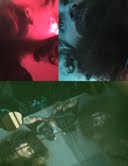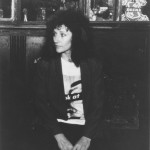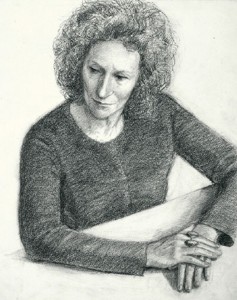 We’re very excited to hear Lynne Tillman, Paul La Farge, and artist duo LoVid perform one week from today at Shrine (7pm on Monday, September 10th at Shrine). We’ve been re-reading Lynne Tillman’s miniature masterpieces, in everything from her latest Someday This Will Be Funny (which the NYTimes calls “gorgeously at ease, technically virtuosic [and]…ever on point,” to her witty and unsettling collaboration with artists This Is Not It. You can sample a piece from Someday This Will Be Funny here: The Substitute. We can’t wait to hear her live and see you there!
We’re very excited to hear Lynne Tillman, Paul La Farge, and artist duo LoVid perform one week from today at Shrine (7pm on Monday, September 10th at Shrine). We’ve been re-reading Lynne Tillman’s miniature masterpieces, in everything from her latest Someday This Will Be Funny (which the NYTimes calls “gorgeously at ease, technically virtuosic [and]…ever on point,” to her witty and unsettling collaboration with artists This Is Not It. You can sample a piece from Someday This Will Be Funny here: The Substitute. We can’t wait to hear her live and see you there!
Category Archives: Authors/Artists
Paul La Farge’s Luminous Airplanes in the NYTimes
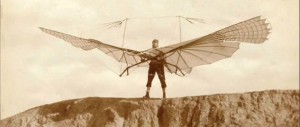 Along with Lynne Tillman and LoVid, Paul La Farge will be reading in the first FPP Harlem reading of the season on September 10th. His latest novel, Luminous Airplanes, will be coming out in paperback on October 2nd! In a New York Times review of the hardcover edition, Kathryn Schultz writes, “Luminous Airplanes isn’t about disconnection and meaninglessness. It is about connection and significance — about the way the past becomes the future, the contingent the inevitable, the spandrel the success, the success the tragedy. It is, in other words, about the ramifying, mysterious ways we human beings affect each other, from parent to child, invention to invention, generation to generation: If, if then, then.” We couldn’t agree more. You can read the rest of the review on the New York Times website.
Along with Lynne Tillman and LoVid, Paul La Farge will be reading in the first FPP Harlem reading of the season on September 10th. His latest novel, Luminous Airplanes, will be coming out in paperback on October 2nd! In a New York Times review of the hardcover edition, Kathryn Schultz writes, “Luminous Airplanes isn’t about disconnection and meaninglessness. It is about connection and significance — about the way the past becomes the future, the contingent the inevitable, the spandrel the success, the success the tragedy. It is, in other words, about the ramifying, mysterious ways we human beings affect each other, from parent to child, invention to invention, generation to generation: If, if then, then.” We couldn’t agree more. You can read the rest of the review on the New York Times website.
The FPP Interview: LoVid on the Art of Collaboration
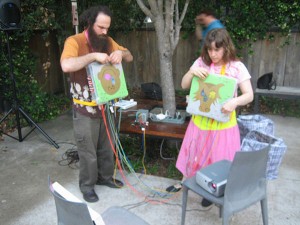 LoVid is an interdisciplinary artist duo comprised of Tali Hinkis and Kyle Lapidus who have been collaborating for over twelve years and married nearly as long. LoVid’s range is wide: they perform using hand-made electronics and interactive choreographies, they create sculpture, video, prints, and large scale installations. Their work combines materials both “hard” (electronic and wireless technologies, scientific data) and “soft” (fabric, paper, human bodies). For more on LoVid, go here.
LoVid is an interdisciplinary artist duo comprised of Tali Hinkis and Kyle Lapidus who have been collaborating for over twelve years and married nearly as long. LoVid’s range is wide: they perform using hand-made electronics and interactive choreographies, they create sculpture, video, prints, and large scale installations. Their work combines materials both “hard” (electronic and wireless technologies, scientific data) and “soft” (fabric, paper, human bodies). For more on LoVid, go here.
Lydia Davis Interviews Lynne Tillman on Electronic Book Review
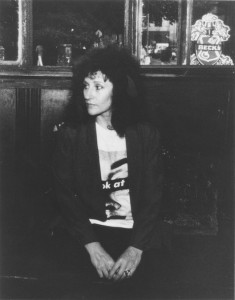 Lydia Davis: Some writers I know are very unhappy writing, and some fly high. On a scale of one to ten, from agonized to elated, what were your feelings in the midst of working on American Genius, A Comedy?
Lydia Davis: Some writers I know are very unhappy writing, and some fly high. On a scale of one to ten, from agonized to elated, what were your feelings in the midst of working on American Genius, A Comedy?
Lynne Tillman: I ran the gamut, from one to ten. One was my not being able to find the voice that moved it all, told it. A ten was, for instance, when I was writing the séance scene, which was so wacky I couldn’t believe I was doing it.
Read the full interview here: http://www.electronicbookreview.com/thread/fictionspresent/uncovered
Can’t Get These Lines out of My Head
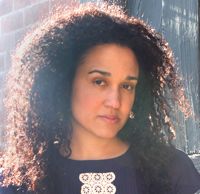 While many people flee New York City once June arrives, rising temperatures make me sentimental. Excursions to Jones Beach and ferry rides remind me of spending summer vacations in the city with my grandparents, who spent most of their life together in the area now known as South Jamaica, Queens. To teach us more about the history of his beloved city, my grandfather made adventures out of our daytrips to the Barnes & Noble on 18th St. and Fifth Avenue; South Street Seaport to watch Operation Sail; and Harlem, where he was born and raised.
While many people flee New York City once June arrives, rising temperatures make me sentimental. Excursions to Jones Beach and ferry rides remind me of spending summer vacations in the city with my grandparents, who spent most of their life together in the area now known as South Jamaica, Queens. To teach us more about the history of his beloved city, my grandfather made adventures out of our daytrips to the Barnes & Noble on 18th St. and Fifth Avenue; South Street Seaport to watch Operation Sail; and Harlem, where he was born and raised.
There is a line in The Great Gatsby that refers to New York as “the fresh, green breast of the new world,” and I hear it in my head whenever I look up the Hudson from the top of Riverside Park. This view inspired me to pick up Manahatta: A Natural History of New YorkCity, by Eric W. Sanderson. The book provides an ecological history of the island through narrative and maps that attempt to reveal what the island looked like before the first settlers arrived in 1609. The project envisions native plant and animal life within neighborhoods as we now know them, in addition to those that might have come to be a part of the city through commerce and traffic. Manahatta offers an imaginative history bolstered by computational geography that helps us to imagine how the island’s future might better reflect its verdant past.
Also on my list for the season is Alison Bechdel’s Are You My Mother?, a follow up to her 2006 groundbreaking novel Fun Home: A Family Tragicomic. Bechdel’s first book focused on her relationship with her father, an undertaker who was closeted and deeply repressed. The trauma of his sudden and perhaps self-inflicted death led Bechdel to want to know more about his life. Are You My Mother? attempts to tell her mother’s side of the story, shifting from her point of view to Bechdel’s growing interest in the history of psychoanalysis. It’s an account of a mother and daughter trying to connect with one another despite a fundamental inability to understand each other. Reviews on this book have been mixed, but I suspect part of the reason for this is that its integration of personal and psychoanalytic history makes it a very ambitious book. I like that.
A couple of weeks ago I caught the tail end of Eduardo Corral’s New York book party for his Yale Younger Poets’s winning collection, Slow Lightning. The reading was over, the wine and cheese were nearly gone, but most disappointing was the fact that the book was sold out! Fortunately I have been able to pick one up in a local bookstore. One of the reasons I am so excited about reading Corral is his well-known affection of the work of Robert Hayden, who is one of the most underappreciated poets of his generation. In a recent interview, Corral explained that Hayden’s work taught him to think about form as an principal aspect of a poem: “My background and my beliefs will pulse through my lines, but the poem has to exist without me, it has to breathe on its own.” I am interested to see how Corral’s deals with form, whether it is through imitation or reinvention—and how he manages this, at times, with a sense of humor. Consider the opening lines to “In Colorado My Father Scoured and Stacked Dishes,” published in the April issue of Poetry: “In a Tex-Mex restaurant. His co-workers,/ unable to utter his name, renamed him Jalapeño.” I can’t get that line out of my head.
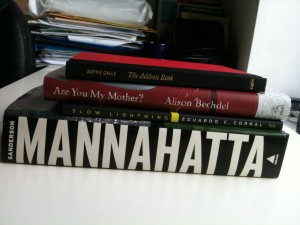 I received an advance copy of Sophie Calle’s The Address Book, which was originally published in 1983. The book is a record of interactions that followed Calle finding an address book in the street. In an attempt to get to know its owner without meeting him, she contacted the persons listed in the book and asked them for a meeting where she would ask them a series of questions. I am particularly intrigued by the idea of comprehending a person through his or her associations, and I am fascinated by Calle’s ability to magnify the ways in which exposing our intimate connections poses a risk to our identity.
I received an advance copy of Sophie Calle’s The Address Book, which was originally published in 1983. The book is a record of interactions that followed Calle finding an address book in the street. In an attempt to get to know its owner without meeting him, she contacted the persons listed in the book and asked them for a meeting where she would ask them a series of questions. I am particularly intrigued by the idea of comprehending a person through his or her associations, and I am fascinated by Calle’s ability to magnify the ways in which exposing our intimate connections poses a risk to our identity.
The other re-release I am looking forward to reading is Fran Ross’s Oreo. First published in 1974, the book was practically ignored by audiences and critics. With a new forward written by vanguard poet Harryette Mullen, it has been republished by University Press of New England. A young woman is born to a Jewish father and black mother who divorce early in her life. She comes to New York to find her father, Sam Schwartz. But there are so many Sam Schwartzes in the phone book that her quest takes a turn to the absurd. A few critics have said it was the funniest book they have ever read. Others have said it remains ahead of its time. Either way, it sounds like a great read.
–Wendy S. Walters
We’re Back! FPP Harlem Opens the Season with Paul La Farge, LoVid and Lynne Tillman on September 10 at Shrine
It’s been a hot summer, but it’s going to be an even hotter fall with the First Person Plural Harlem Reading Series! We kick off our second season with a line up of writers and performance artists who are sure to delight us with their original voices. Prepare to be inspired by the work of Paul La Farge, LoVid and Lynne Tillman. Join us Monday, September 10 at 7pm Shrine for another singular event!
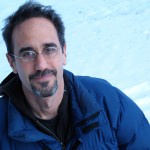 Paul La Farge is the author of three novels: The Artist of the Missing (FSG, 1999) and Haussmann, or the Distinction (FSG, 2001), and Luminous Airplanes (FSG, 2011); and a book of imaginary dreams, The Facts of Winter (McSweeney’s Books, 2005). He is the grateful recipient of a Guggenheim Fellowship, the Bard Fiction Prize, and fellowships from the New York Foundation for the Arts and the National Endowment for the Arts. http://paullafarge.com/
Paul La Farge is the author of three novels: The Artist of the Missing (FSG, 1999) and Haussmann, or the Distinction (FSG, 2001), and Luminous Airplanes (FSG, 2011); and a book of imaginary dreams, The Facts of Winter (McSweeney’s Books, 2005). He is the grateful recipient of a Guggenheim Fellowship, the Bard Fiction Prize, and fellowships from the New York Foundation for the Arts and the National Endowment for the Arts. http://paullafarge.com/
LoVid is the art duo of Tali Hinkis and Kyle Lapidus. LoVid explores translation and decay of natural, electrical, and biological systems. Working together since 2001, LoVid
produces works that combine hand-made and machine produced craft, DIY electro-engineering, textile, video, and noise. LoVid has performed and exhibited at Museum of Contemporary Art, Raleigh (NC), Museum of Moving Image (NY), International Film Festival Rotterdam, MoMA, PS1, The Kitchen, Netherlands Media Art Institute, The Jewish Museum (NY), The Neuberger Museum, and The New Museum among many others. LoVid has received grants and awards from: Foundation for Contemporary Arts, Eyebeam, Rhizome, Franklin Furnace Fund, NY Foundation for the Arts, Lower Manhattan Cultural Council, NY State Council on the Arts, and Greenwall Foundation. http://www.lovid.org/
Lynne Tillman is a novelist, short story writer, and critic. Her most recent book, and fourth collection of stories, Someday This Will Be Funny, was published in April 2011 by Red Lemonade Press. Her most recent novel, American Genius, A Comedy, was published by Soft Skull Press in 2006, and was cited as one of the best books of the Millennium (so far) by The Millions. Her other novels are Haunted Houses, Motion Sickness, Cast in Doubt, and No Lease on Life, a finalist for the National Book Critics Circle Award in fiction and a New York Times Notable Book of the Year. She has published three nonfiction books, including The Velvet Years: Warhol’s Factory 1965- 67, based on photographs by Stephen Shore. Her other story collections include This is Not It, stories and novellas written in response to the work of 22 contemporary artists. Her work has appeared in journals, such as Tin House, McSweeney’s, Black Clock, Bomb, Aperture, and Conjunctions; her criticism in Artforum, Frieze, Aperture, Nest, The Guardian, and The New York Times Book Review. In 2006 she was awarded a Guggenheim Fellowship, and, in the same year, her papers were acquired by New York University’s Fales Library. She was the fiction editor of Fence magazine for 15 issues, and is a contributing editor to Bomb magazine, and on the boards of Housing Works, Triple Canopy, and a Trustee of PEN American Center. Tillman is Professor/Writer-in-Residence at The University at Albany; teaches in the Riggio Program, Writing and Democracy, at The New School, and at School of Visual Art’s MFA in art criticism program. http://www.albany.edu/writers-inst/webpages4/archives/tillman_lynne.html
Venue:
Shrine World Music Venue
(in Black United Fun Plaza)
September 10, 2012 @ 7pm
2271 Adam Clayton Powell Blvd.
http://www.shrinenyc.com/
Personal Draw
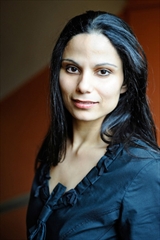 I feel lucky. This summer, the book stack next to me is more than “assigned” reading: they are the works of beloved mentors, or of subjects that are close to me, figuratively and literally.
I feel lucky. This summer, the book stack next to me is more than “assigned” reading: they are the works of beloved mentors, or of subjects that are close to me, figuratively and literally.
First in line is The Killing Jar by Gloria Nixon-John and Robert Skip Noelker, based on the true story of one of the youngest Americans to be charged with murder and sentenced to death. I am not usually a true crime reader (unless you count political coverage), but the authors go deep on the story of this rural Kentucky boy’s upbringing, and the harms he suffered before turning the violence outwards. They also examine the community’s role, or, culpability, at every tragic turn. Gloria is a deeply inspiring teacher of mine, and I’m glad she is getting this story told.
Next: Terry Blackhawk’s book of poems The Light Between. I’ve known and admired Terry for many years now, having worked for her Detroit literary arts nonprofit InsideOut and having read her previous books. This book—which Pete Markus hails as her best—is about the death of a marriage, and the resilience, and the rebirth, of the poet. Such a feeling to hold in my hands the artful results of this traumatic yet blessed time in my friend’s life.
Next: Salvage the Bones by Jesmyn Ward. I’m excited to read this National Book Award-winning novel because it’s a “Katrina novel”, yes, but more so because it’s a family, coming-of-age narrative told from the POV of a young black woman on the Mississippi side of the storm. Continued personal draw: I work on a Katrina oral history project. I am looking forward to taking in Ward’s insights, and witnessing the aftermath through new eyes.
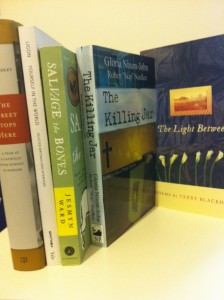 Turning to art: Yourself in the World: Selected Writings and Interviews by Glenn Ligon, edited by Scott Rothkopf. I still think often of the recent Ligon Whitney show, and I see his “Give Us a Poem” sculpture whenever I pass the Studio Museum, for it is visible from the street. I flipped through this book Harlem Flo’s gift shop and thought, I want to know more about Ligon. So I’m reading.
Turning to art: Yourself in the World: Selected Writings and Interviews by Glenn Ligon, edited by Scott Rothkopf. I still think often of the recent Ligon Whitney show, and I see his “Give Us a Poem” sculpture whenever I pass the Studio Museum, for it is visible from the street. I flipped through this book Harlem Flo’s gift shop and thought, I want to know more about Ligon. So I’m reading.
Finally, turning around (literally) to Rice High School—or, the building that housed it—that stands behind my apartment. This Catholic high school closed down last year. Yet, I’m mesmerized by this building that keeps its lights on all night long—or at least enough of them to create a moody nighttime checkerboard. I stand in my kitchen and stare into floor after floor of windows and I wonder about the history, the ghosts. So I ordered: The Street Stops Here: A Year at a Catholic High School in Harlem by Patrick J. McCloskey. Word is, a new charter school is going to take over the building. But before that happens, I will learn about the highs, and maybe the lows, of this once great institution.
–Stacy Parker LeMelle
Tiphanie Yanique: The FPP Harlem Interview
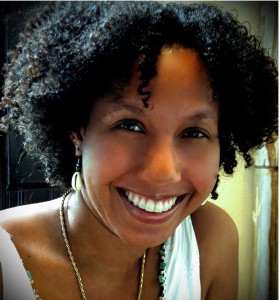 FPP Harlem spoke with the spellbinding fiction writer Tiphanie Yanique (How to Escape from a Leper Colony) about “juicy, fatty” novels, when the POV has to be “we,” and enchantment as a family tradition.
FPP Harlem spoke with the spellbinding fiction writer Tiphanie Yanique (How to Escape from a Leper Colony) about “juicy, fatty” novels, when the POV has to be “we,” and enchantment as a family tradition.
What’s the best thing about reading to a live audience?
I love the immediate reaction you can get. As a writer, most of my audience is people who I will never see. It’s nice to see them. I also love giving readings because I dig community. Reading to an audience feels like a community endeavor. To read the rest of the interview, go here.
Ed Park: The FPP Harlem Interview
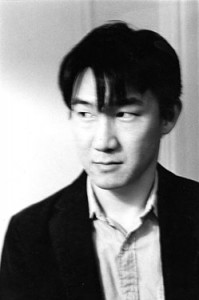 FPP Harlem spoke with our “first person corporate” author Ed Park (Personal Days) about walls of prose that resemble Chinese calligraphy, the opportunities afforded by the first person plural voice, and faded gyro posters from 1997.
FPP Harlem spoke with our “first person corporate” author Ed Park (Personal Days) about walls of prose that resemble Chinese calligraphy, the opportunities afforded by the first person plural voice, and faded gyro posters from 1997.
Can you tell us a little about your current writing project?
What began as a modest collection of my short pieces (both fiction and nonfiction) has turned into something else. The working title is Two Laptops, which is also the title for several of the new pieces in the book. The new pieces (or ideas for new ones) are now bumping out many of the old ones (i.e., the initial premise/scaffolding). The working title is imposing some sort of new, more interesting order on the material. To read more of this interview, go here.
Bathsheba Doran: The FPP Harlem Interview
FPP Harlem spoke with acclaimed playwright and screenwriter Bathsheba Doran (Kin, Parents’ Evening, and Living Room in Africa), about “we” vs “me,” the writer’s life in Harlem, and what current play we need to see right this minute.
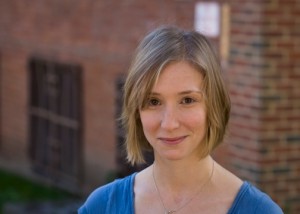 Do you create characters that exist outside of your personal sense of we?
Do you create characters that exist outside of your personal sense of we?
I create characters out of me not we. If my characters don’t reflect a part of myself then I don’t understand them so they end up disappearing from drafts. I don’t always know at first what part of myself the character has accessed, but at some point I’ll realize they’re made up of a certain emotional makeup I experienced at some point in my past. And the dream is that other people will see themselves in my me, then it’s a we, and hopefully we’re all less lonely for a second. For more of this interview, go here.

